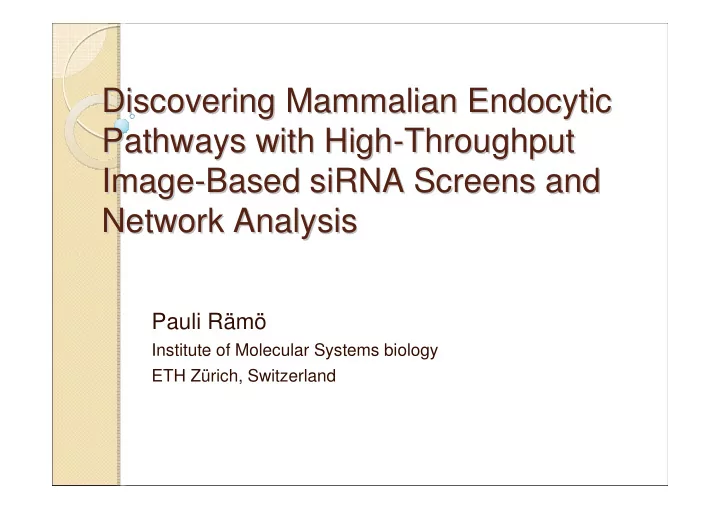

Discovering Mammalian Endocytic Discovering Mammalian Endocytic Pathways with High- -Throughput Throughput Pathways with High Image- -Based siRNA Screens and Based siRNA Screens and Image Network Analysis Network Analysis Pauli Rämö Institute of Molecular Systems biology ETH Zürich, Switzerland
Outline Outline • Background in endocytosis and virus entry • Biological assays − siRNA technology − Virus infection assays • Data analysis – Phenotypical readouts • Human protein interaction databases • Network based methods − Data analysis, integration and visualization • Summary
Background in endocytosis and Background in endocytosis and virus entry virus entry � Viruses enter the cell through endocytic pathways ◦ Higher organisms such as mammals have many different endocytic pathways ◦ Currently, the pathways and the genes involved in the steps of these pathways are only partially known
siRNA technology siRNA technology � Small interfering RNAs (siRNA) are double- stranded RNA molecules that can be artificially created to knock-down specific genes � Companies have generated libraries of siRNAs that target most or a subset of human genes � Problems with the siRNA technology ◦ Individual siRNAs may have a considerable off- target phenotypes or varying silencing efficiencies ◦ In practice, several siRNAs are used to silence each target gene
Virus infection assays 1/2 Virus infection assays 1/2 � Our goal is to find host gene knock-downs that cause changes in the level of infection of various viruses ◦ Integrating the data will help us to discover which pathways different viruses use and which genes constitute the main components of these pathways � In our assays we use: ◦ Human culture cells (e.g. HeLa cells) ◦ 7000 genes each targeted with 3 individual siRNAs � Results in more than 200 384-well plates and 1TB of measurement data per virus ◦ So far 6 different viruses
Virus infection assays 2/2 Virus infection assays 2/2 � Virus infection assays ◦ siRNA transfection ◦ Cell seeding ◦ Virus infection ◦ Cell fixation and staining � Automated low resolution microscopy � Automated image analysis
SFV SV40
Data analysis Data analysis • Image analysis – We use CellProfiler toolbox to perform our image analysis on a computer cluster • Cell segmentation • Feature extraction • Detection of infected cells � Data coming from large-scale screens must first be checked for quality and normalized � We have developed statistical hit estimation methods for large-scale siRNA screens ◦ We measure different phenotype “hits” for each knock- down
Phenotypical readouts Phenotypical readouts � Image based siRNA assays allow wide possibilities for phenotypical readouts ◦ Level of infection ◦ Support vector machine (SVM) classification of cellular phenotypes � Interphase, mitotic, or apoptotic nuclei � Different staining patterns ◦ We discovered that infection patterns depend on cell population properties � Local cell density � Cell size � Total cell number � Cells on colony edges � We developed a model to correct (and use) these correlations
Human protein interaction Human protein interaction databases databases � Human protein-protein and genetic interaction networks are much worse known than for other model organisms � Some protein-protein interaction databases are promising ◦ HPRD (human protein reference database), interactions from literature ◦ STRING, protein interactions for example from literature, species orthologs, and co-expression assays ◦ Ingenuity, a commercial literature based interaction database and data visualization tool
Network based methods Network based methods ◦ Our network based approaches include � Using information from existing protein-protein interactions as a-priori knowledge for hit detection � Care should be taken since the low quality of the network data � Finding enriched subnetworks � Integrate networks with our own phenotypical data � Finding correlations between the data and network properties (e.g. hit probability vs. node degree) � Data visualization ◦ Some ideas on the following slides…
Hierarchical clustering of Hierarchical clustering of genes genes Gene A Gene B Gene C Gene D Gene E Phenotype 1 1 1 0 0 0 Phenotype 2 0 1 1 0 0 Phenotype 3 0 0 0 1 1 Phenotype 4 0 0 1 1 1 General regulators (hubs) D B D E A E C B 3 Specific C A ? regulators 1 (leaves) 2 1 2 3 4 4 - Data integration (interactions, annotations) and understanding
Interactions between hits Interactions between hits
Human genome as a clustergram
Summary Summary � Image based siRNA screens are experimentally, computationally and statistically difficult ◦ Provide huge potential for computational biologists � Network based data analysis approaches are interesting in this context as ◦ Natural framework for data integration ◦ Finding enriched subnetworks ◦ Data visualization
Acknowledgements Acknowledgements � Our lab: ◦ Lucas Pelkmans ◦ Berend Snijder ◦ Raphael Sacher ◦ David Lamparter ◦ Lilli Stergiou ◦ Eva-Maria Damm ◦ Mirko Birbaumer ◦ Manuel Bauer ◦ Herbert Polzhofer ◦ Karin Mench � EMBO � Human Frontier Science Program
Recommend
More recommend